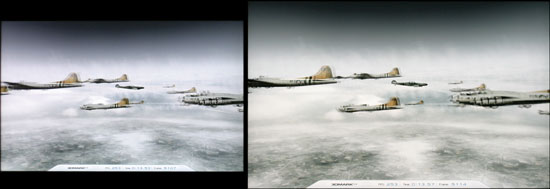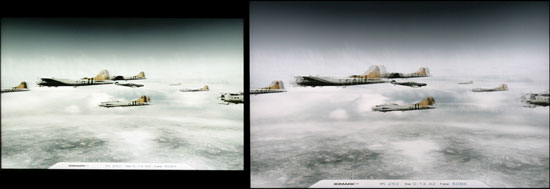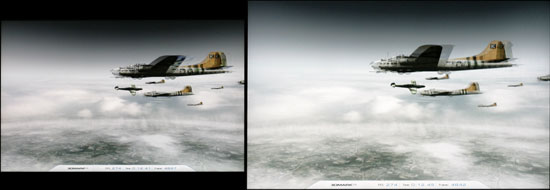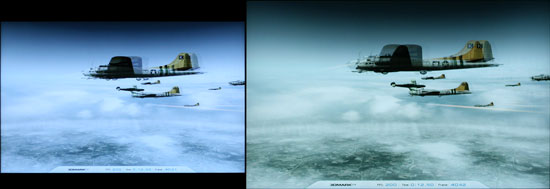Input Lag and Response Times
We've heard frequent complaints about input lag on various LCDs, particularly after our last review of the Samsung 245T. We decided it was time to take a closer look at the subject and see if we could come up with a repeatable test. We ended up settling on a test similar to what we were using to show response times, with a few changes.
We run the Wings of Fury benchmark in 3DMark03, with the resolution set to the native LCDs resolution -- in this case 1920x1200. Our test system is an overclocked quad-core Q6600 (3.30 GHz) running two Radeon HD 3870 cards in CrossFire on a Gigabyte GA-X38-DQ6 motherboard. (This is the same system used in our initial testing of 3DMark vantage.) We connect the test LCD and a reference LCD to two outputs from the Radeon 3870 and set the monitors to run in clone mode.
The reference Monitor is an HP LP3065, which we have found to be one of the best LCDs we currently possess in terms of not having input lag. (The lack of a built-in scaler probably has something to do with this.) [Ed: Before you ask, no, I do not have any CRTs around that I can use as a reference monitor, and frankly I don't want any. They're huge, heavy, and require more power, and the best ones were made over five years ago. Sorry - LCDs are where everything is heading. R.I.P. CRT.]
While the benchmark is looping, we snap a bunch of pictures of the two LCDs sitting side-by-side. We set our camera to f/2.2, ISO-400, and a 1/400 sec exposure in order to get a clear snapshot of the on screen action. (Note that these settings have changed from previous articles.) 3DMark03 lists a runtime with a resolution of 10 ms at the bottom of the display, and we can use this to estimate whether a particular LCD has more or less input lag in our reference LCD. We then sort through the images and discard any where the times shown on the LCDs are not clearly legible, until we are left with 10 images for each test LCD. We record the difference in time relative to the HP LP3065 and average the 10 results to come up with an estimated input lag value.
It's important to note that this is merely an estimate -- whatever the reference Monitor happens to be, there are some inherent limitations. For one, LCDs only refresh their display 60 times per second, so any measurement less than approximately 17 ms is not 100% accurate. Second, the two LCDs can have mismatched vertical synchronization, so it's entirely possible to end up with a one frame difference on the time readout purely because of this. That's why we average the results of 10 images, and we are confident that our test procedure can at least show when there is a consistent input lag/internal processing delay.
Here is a summary of our results, followed by a sample image chosen to highlight the pixel response time of the LCDs. Despite what the manufacturers might advertise as their average response time, we found most of the LCDs were equal in this area -- they all show roughly a one frame "lag", which equates to a response time of around 16 ms.
| Display Input/Processing Lag vs. HP LP3065 | |||||||||||
| One | Two | Three | Four | Five | Six | Seven | Eight | Nine | Ten | Average (ms) | |
| ASUS MK241H | 10 | 0 | 0 | 0 | 0 | 0 | 0 | 0 | 0 | 0 | 1 |
| Dell 2407WFP | 10 | 20 | 30 | 20 | 10 | 10 | 30 | 30 | 10 | 20 | 19 |
| Dell 2408WFP | 30 | 40 | 40 | 40 | 30 | 30 | 40 | 30 | 50 | 50 | 38 |
| Gateway FHD2400 | -10 | -10 | 0 | 10 | 10 | 10 | 0 | 10 | 10 | 0 | 3 |
| Gateway FPD2485W | 30 | 10 | 20 | 20 | 20 | 10 | 0 | 30 | 20 | 20 | 18 |
| HP w2408 | 10 | 10 | 0 | 0 | 0 | 0 | 0 | 10 | 0 | 0 | 3 |
| LaCie 324 | 40 | 30 | 40 | 30 | 40 | 50 | 40 | 50 | 50 | 30 | 40 |
| Samsung 245T | 30 | 30 | 30 | 30 | 30 | 20 | 30 | 30 | 20 | 20 | 27 |
| Samsung 2493HM | 0 | 10 | 0 | 0 | 0 | 10 | 0 | -10 | 0 | 10 | 2 |
 ASUS MK241H |
 Dell 2407WFP |
 Dell 2408WFP |
 Gateway FHD2400 |
 Gateway FPD2485W |
 HP w2408 |
 LaCie 324 |
 Samsung 245T |
 Samsung 2493HM |
The table tells a clear story: all of the S-PVA panels as we mentioned clearly have more input lag/internal processing lag than all of the TN panels. This is a pretty shocking result, as it indicates that the problem may actually be inherent in S-PVA technology, although there are still panels that do better in this area. The Gateway FPD2485W and Dell 2407WFP both have an input lag just under 20 ms -- or a one frame delay on average. The Samsung 245T has a 27 ms delay on average, indicating it would be one or two frames behind what is actually happening. Worst of all are the Dell 2408WFP in the LaCie 324, which have a two or three frame lag. (This is discounting any other lag that is present between the user and what they are seeing on the display; there's also a slight amount of lag associated with reading input from your mouse/keyboard, processing that input, rendering the resulting image, and sending that to your display.) In contrast, the four 24" TN panel LCDs all more or less match the HP LP3065.
Thus, we have no choice but to conclude that if you are seriously concerned about input lag, you will have to sacrifice viewing angles, color accuracy, and/or overall display quality in order to avoid this on the current 24" offerings. On the other hand, we have played games on all of the test LCDs, and we honestly can't say that we noticed any difference in our overall performance. But we weren't hopped up on Bawls and we don't have a 1337 name like Fatal1ty. Competitive gamers will probably feel differently.










89 Comments
View All Comments
Dainas - Friday, May 2, 2008 - link
Well, it would not be as much fun as if they had done it 3 months ago. All the sub-$500 'jewels' have been dissapearing from the market. Just as well though, might as well review something that will still be easy to buy +6 months down the road.JarredWalton - Friday, May 2, 2008 - link
It shouldn't be too much of a surprise that the cheapest LCDs often have much lower quality. That being the case, most of the manufacturers of cheap LCDs are unwilling to send us review units. Hence, we end up with 24" roundups (and some upcoming 27 and 30" units as well).That said, I think more people should bite the bullet and splurge on a really nice display. I couldn't imagine running an SLI or CrossFire system without at least a 24" monitor, and having upgraded to a 30" LCD 18 months back I've never regretted the decision. I hope to continue to use my 30" LCD for at least another 5 years; try saying that about the rest of a PC. $500 sounds like a lot, but a good display can last through several PC upgrades.
Basilisk - Friday, May 2, 2008 - link
I have to agree with the original poster on this sub-thread. There's nothing about these four units that command my interest yet. If you're not shipped the units, I still find it surprising that you don't know folks who've bought the cheaper units -- I do -- or a store manager who might loan them. Whatever, you have your criteria, even if they edge your review towards irrelevance for me."That said, I think more people should bite the bullet and splurge on a really nice display." Well... that's been my strategy in life, but I've now retired and the economic picture has changed; others haven't the coins to spare or a need that justifies the extra bucks. I game, but nothing requiring high speed LCDs; I work with pictures, but nothing that justifies full color gamut monitors. So... what is there beyond elitism to recommend spending an extra $200-$400 for something I won't use? Some might call that an immature purchase decision, not splurging. I'd have loved to see the OfficeMax Soyo 24" monitor -- recurringly sold at $275 -- included so I'd know why NOT to buy it, or to.
Well, I'll probably skip the 24" size and make a 28" my next purchase anyway: at my age, size matters. :) The old orbs are becoming challenged using my 21" CRT and 22" WS LCD on detailed web pages.
strikeback03 - Tuesday, May 6, 2008 - link
For our lab we have bought a few of the Westinghouse 24" monitors Newegg sells for ~350 (After rebate) and for the price I'd assume they use a TN panel, but it has very good viewing angles.http://img.photobucket.com/albums/v315/strikeback0...">http://img.photobucket.com/albums/v315/strikeback0...
Have not had a chance to try color calibration. Seems it's biggest problems are 1) no DVI, and over HDMI it goes to blue screen instead of sleep when the signal is cut; and 2) the controls for the OSD are awful, they are on the side of the monitor so you have to try and look at their tiny labels and look around at the screen to do anything.
Dainas - Thursday, May 1, 2008 - link
Well its partly bullshit, there is a lolair MVA (different take on PVA) that has zero input lag and is lighting fast even among TNs.I can assure you of one thing, the lag in the PVA 2408WFP and LaCie is however definitely not due to the panel. Just as the 3008WFP IPS is as slow as mud next to the 3007WFP IPS due to its built in scalar. But Dell panels were never fast and I'm sure a PVA could be made as fast as the fastest MVAs, which are as fast as TNs as any sane gamer could be concerned.
Dainas - Thursday, May 1, 2008 - link
No edit function, ugh.JarredWalton - Friday, May 2, 2008 - link
I'm not at all sure that PVA can be made as fast as TN. If it can, then why do the Gateway LCDs behave so differently? The interface is practically the same and they both use Faroudja video processors. Why would Gateway use one scaler on their S-PVA and a different one on the TN - particularly if the TN scaler appears better?I don't doubt that they can reduce the lag, but you'll notice out of nine LCDs five have lag of 18ms or more and four have virtually no lag; the four without lag are TN and the five with lag are S-PVA. The circumstantial evidence is pretty significant.
Pirks - Thursday, May 1, 2008 - link
http://www.newegg.com/Product/Product.aspx?Item=N8...">http://www.newegg.com/Product/Product.aspx?Item=N8...Dying to see this reviewed!
Puhleeeasseee with sugar on top
Okay? :D
timmiser - Monday, May 5, 2008 - link
This is my monitor I've been using for the past 6 months and I absolutely love it. I bought mine at Costco.com for the same price that most of those 24" were selling for at the time. One thing about is the fact that is has the same resolution as the 24" screens so everything is a bit larger but to me, that is a good thing. I had one 19" Hanns-G monitor prior to this and can agree on the cheapness but this one I feel is of very high quality and no complaints yet.Googer - Friday, May 2, 2008 - link
I have read multiple HANS-G monitor reviews from other hardware sites in the past and the consensus is that HANS-G monitors are cheaply made to match the cheap price tag, typically resulting in a poor review.